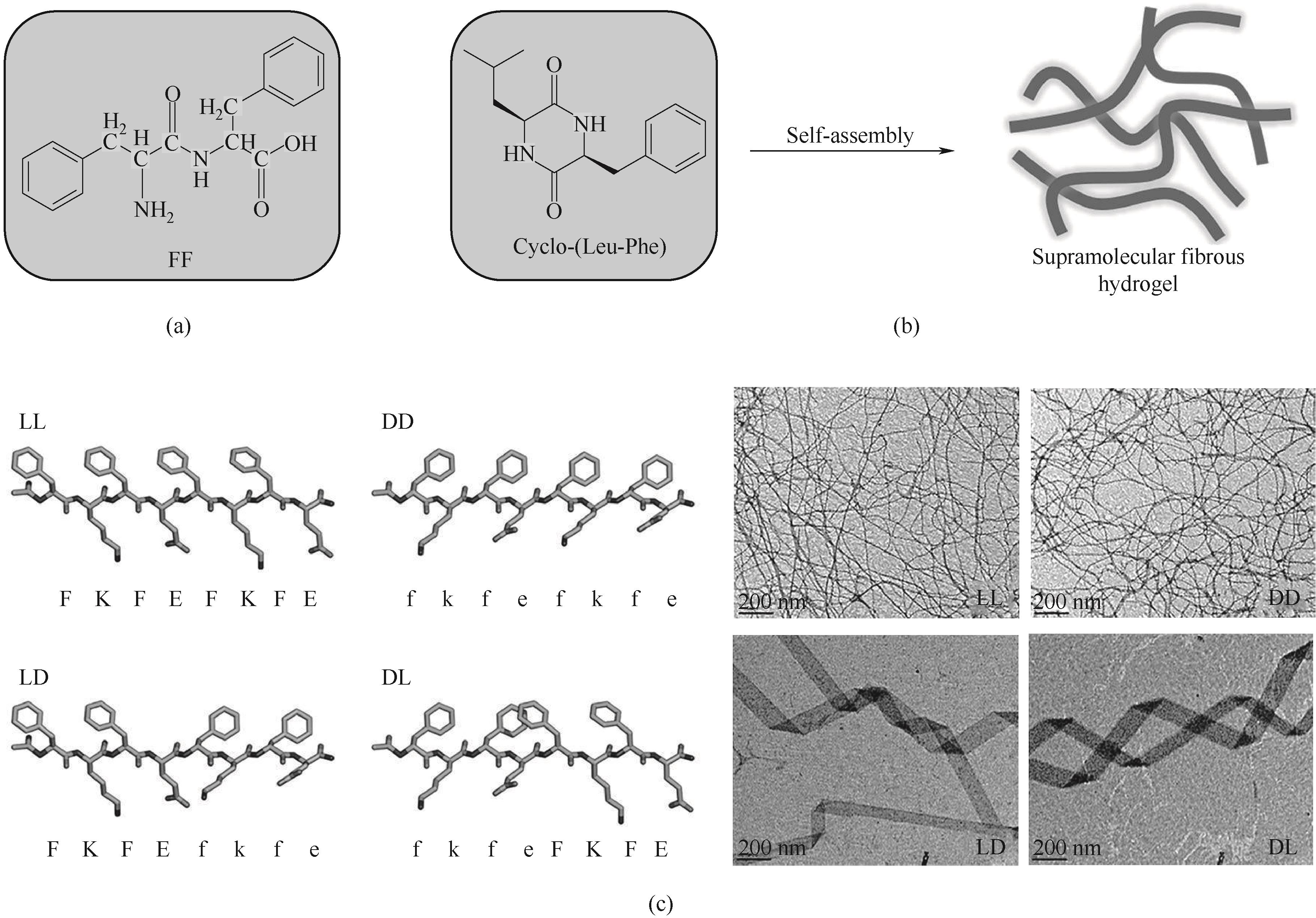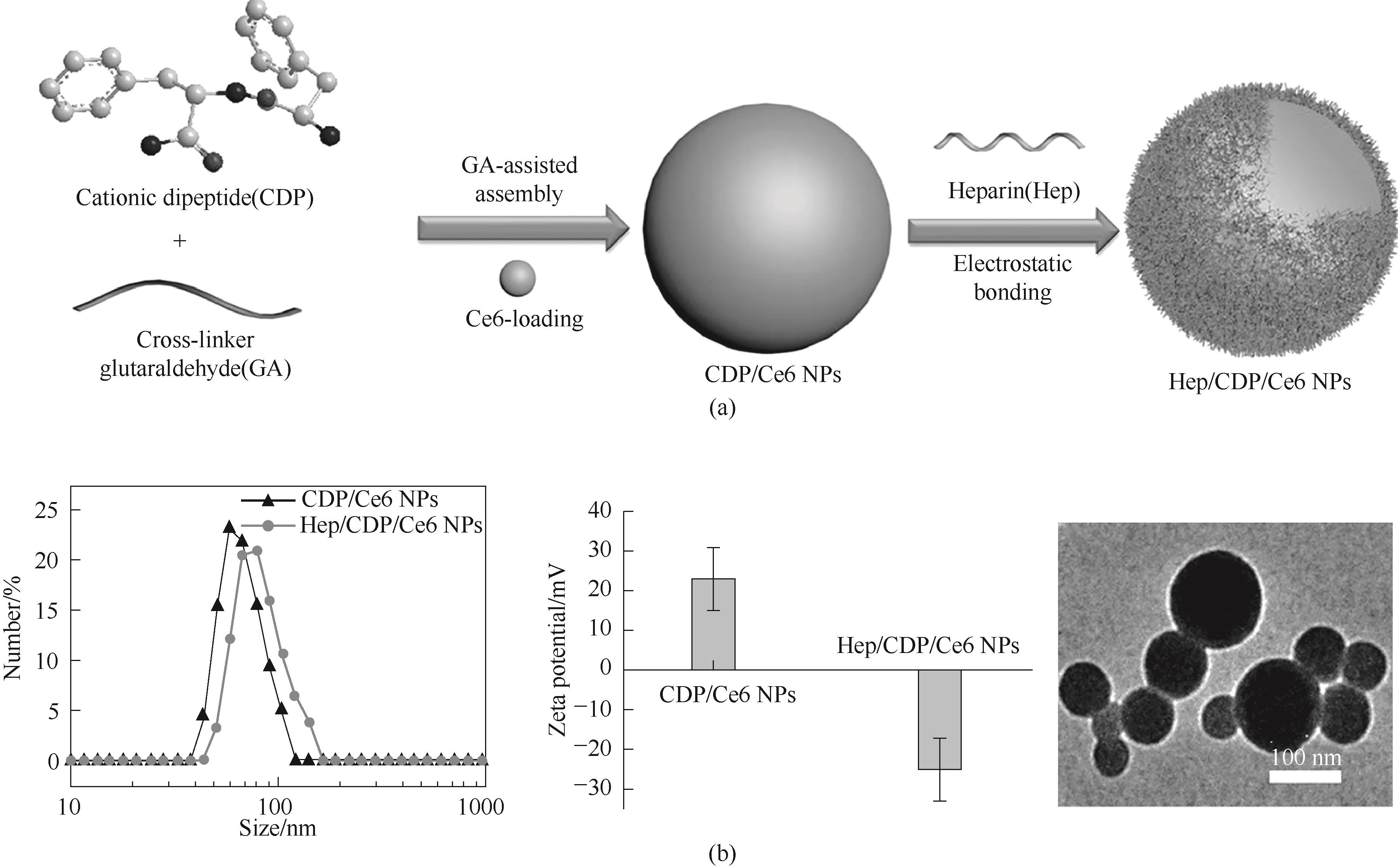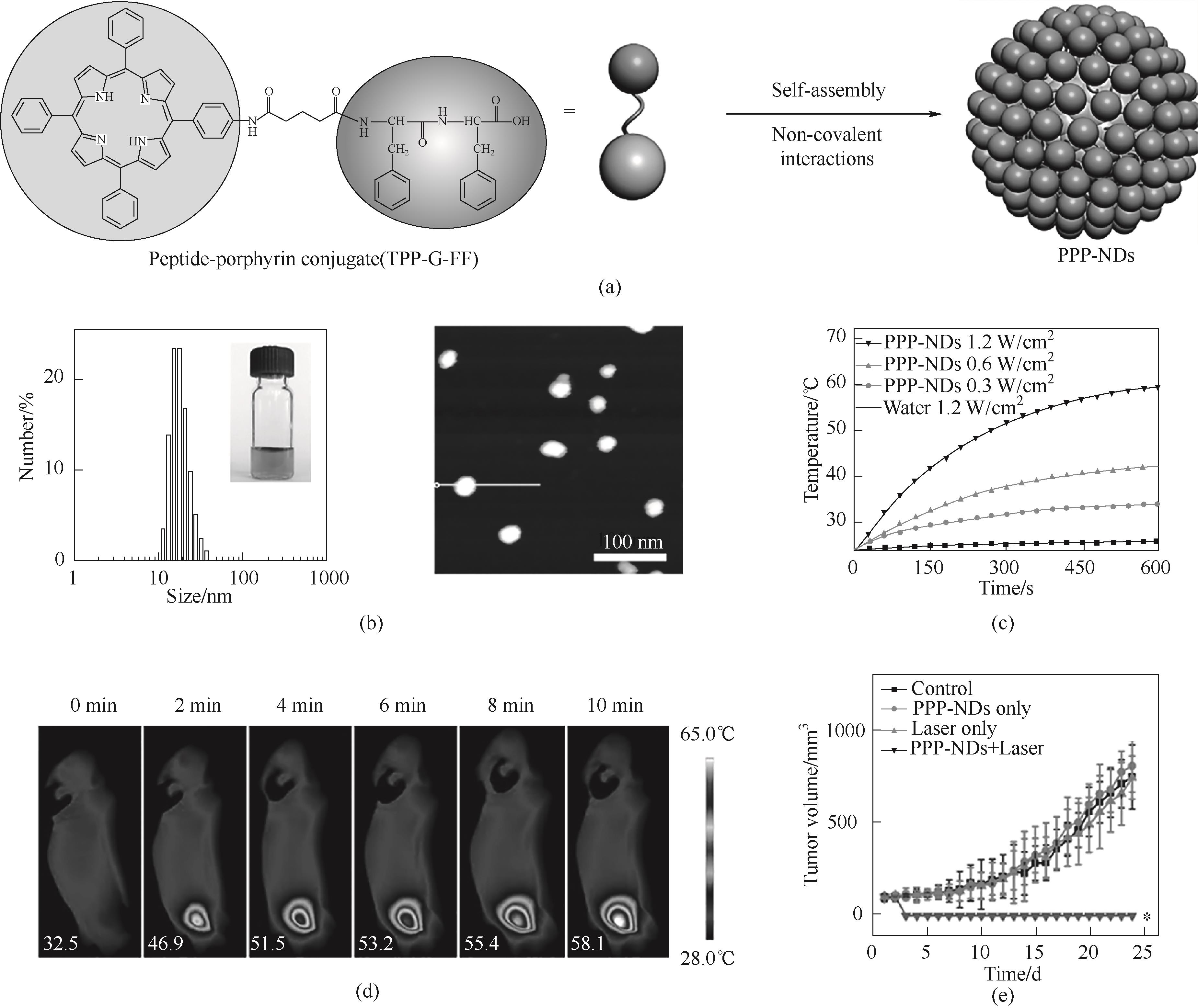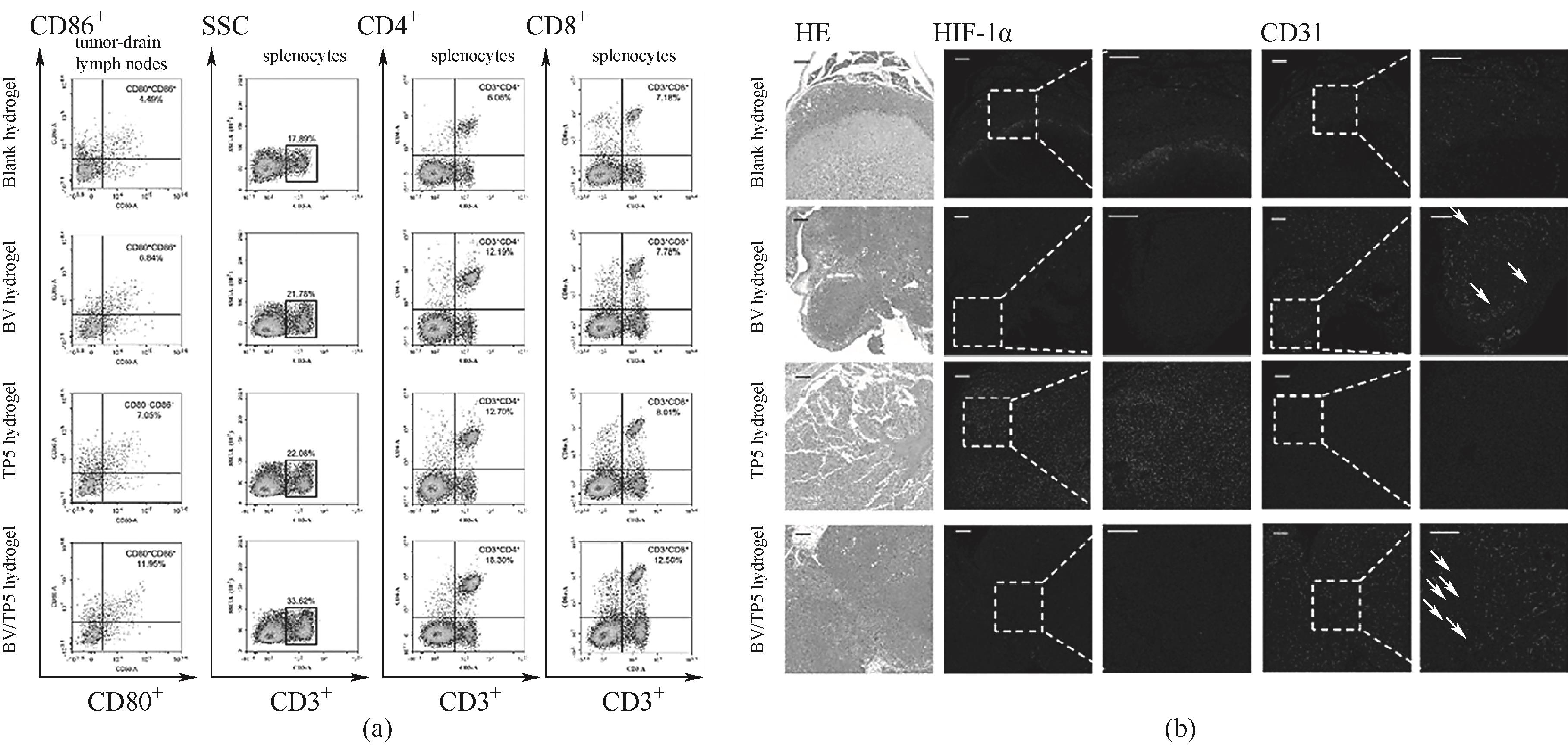CIESC Journal ›› 2024, Vol. 75 ›› Issue (4): 1317-1332.DOI: 10.11949/0438-1157.20231293
• Reviews and monographs • Previous Articles Next Articles
Rui CHANG1( ), Ruirui XING1,2(
), Ruirui XING1,2( ), Xuehai YAN1,2(
), Xuehai YAN1,2( )
)
Received:2023-12-04
Revised:2024-02-07
Online:2024-06-06
Published:2024-04-25
Contact:
Ruirui XING, Xuehai YAN
通讯作者:
邢蕊蕊,闫学海
作者简介:常蕊(1994—),女,博士后,changrui@ipe.ac.cn
基金资助:CLC Number:
Rui CHANG, Ruirui XING, Xuehai YAN. Green and biorecyclable materials based on peptide noncovalent chemistry[J]. CIESC Journal, 2024, 75(4): 1317-1332.
常蕊, 邢蕊蕊, 闫学海. 基于非共价化学的绿色生物可循环肽材料[J]. 化工学报, 2024, 75(4): 1317-1332.
Add to citation manager EndNote|Ris|BibTeX

Fig.4 (a) Molecular structure of FF; (b) Schematic diagram of supramolecular fibrous hydrogel formed by self-assembly of Cyclo-(Leu-Phe)[35]; (c) Negative-stain transmission electron microscopy (TEM) images of block heterochiral analogs of the amphipathic peptide KFE8 and the formation of assemblies[36]

Fig.5 (a) Scanning electron microscopy (SEM) image of microsphere structure[39]; (b) TEM image of fiber bundles[40]; (c) Extinction of anisotropic photoluminescence (as denoted by arrows) at the cross-points of orthogonal fiber bundles under crossed polarizers[40]; (d) Circular dichroism of fiber bundles and J-aggregates[40]; (e) Molecular structure of Z-HF, Zn2+, and Ce6; (f) Particle size and SEM image of Z-HF/Zn2+/Ce6 nanoparticles[42]; (g) Molecular structure of TP5 and ICG; (h) TEM image and atomic force microscopy (AFM) image of nanofibers[43]
| 策略名称 | 构筑基元 | 优势 | 不足 | 应用范围 |
|---|---|---|---|---|
| 特定肽序列的自组装 | 肽序列 | 简单、易操作 | 受限于自身具备的性质及结构 赋予的性质 | 疾病相关蛋白纤维化的机理研究、生物光学和光电设备、3D组织培养 |
| 其他分子调控肽自组装 | 其他分子、肽序列 | 增加新功能和 结构 | 易泄漏、装封率不可控 | 光催化、成像、光动力/热治疗、免疫 治疗 |
| 其他分子与肽生成缀合物的自组装 | 其他分子-肽缀合物 | 增加稳定性、可控装封率 | 缀合物需分离提纯,或需引用 连接剂,过程复杂 | 光动力/热治疗、成像、载药、化疗 |
Table 1 Advantages, disadvantages, and application scope of three strategies for designing peptide materials based on noncovalent chemistry
| 策略名称 | 构筑基元 | 优势 | 不足 | 应用范围 |
|---|---|---|---|---|
| 特定肽序列的自组装 | 肽序列 | 简单、易操作 | 受限于自身具备的性质及结构 赋予的性质 | 疾病相关蛋白纤维化的机理研究、生物光学和光电设备、3D组织培养 |
| 其他分子调控肽自组装 | 其他分子、肽序列 | 增加新功能和 结构 | 易泄漏、装封率不可控 | 光催化、成像、光动力/热治疗、免疫 治疗 |
| 其他分子与肽生成缀合物的自组装 | 其他分子-肽缀合物 | 增加稳定性、可控装封率 | 缀合物需分离提纯,或需引用 连接剂,过程复杂 | 光动力/热治疗、成像、载药、化疗 |

Fig.8 (a) Schematic diagram of glutaraldehyde (GA)-assisted CDP cross-linking self-assembly process; (b) Particle size, potential, and TEM image of peptide based nanospheres[61]

Fig.9 (a) Schematic diagram of TPP-G-FF self-assembled into nanodots; (b) Particle size and AFM image of nanodots; (c) Temperature elevation curves of nanodots under different laser power irradiation; (d) Infrared thermal images of mouse tumor sites within 10 min of continuous laser irradiation; (e) Changes in tumor volume in different groups of mice[46]

Fig.10 (a) Representative flow cytometry images of the ratio of mature DCs (CD11c+CD80+CD86+) in tumor-draining lymph nodes and the percentage of CD3+CD45+, CD3+CD4+, and CD3+CD8+T cells in mouse spleen cells in each treatment group; (b) Representative H&E and IF staining images of HIF-1α and CD31 positive areas in mouse tumor[62]

Fig.11 (a) Schematic diagram of manufacturing bioglass through heating, melting, and quenching and cooling methods; (b) In situ XRD and in situ Raman spectra as a function of temperature; (c) Schematic diagram of 3D printer and photos of printed glass architecture; (d) Image of degradation of glass beads in composting soil; (e) Anatomical photos of glass beads on mouse skin[75]
| 1 | Doane T, Burda C. Nanoparticle mediated non-covalent drug delivery[J]. Adv. Drug Delivery Rev., 2013, 65(5): 607-621. |
| 2 | Müller-Dethlefs K, Hobza P. Noncovalent interactions: a challenge for experiment and theory[J]. Chem. Rev., 2000, 100(1): 143-168. |
| 3 | Schreiber C L, Smith B D. Molecular conjugation using non-covalent click chemistry[J]. Nat. Rev. Chem., 2019, 3: 393-400. |
| 4 | Zhang S G. Fabrication of novel biomaterials through molecular self-assembly[J]. Nat. Biotechnol., 2003, 21: 1171-1178. |
| 5 | Zimmerman J B, Anastas P T, Erythropel H C, et al. Designing for a green chemistry future[J]. Science, 2020, 367(6476): 397-400. |
| 6 | Chang R, Nikoloudakis E, Zou Q L, et al. Supramolecular nanodrugs constructed by self-assembly of peptide nucleic acid-photosensitizer conjugates for photodynamic therapy[J]. ACS Appl. Bio. Mater., 2020, 3(1): 2-9. |
| 7 | Abbas M, Zou Q L, Li S K, et al. Self-assembled peptide- and protein-based nanomaterials for antitumor photodynamic and photothermal therapy[J]. Adv. Mater., 2017, 29(12): 1605021. |
| 8 | Reches M, Gazit E. Casting metal nanowires within discrete self-assembled peptide nanotubes[J]. Science, 2003, 300(5619): 625-627. |
| 9 | Zou Q L, Liu K, Abbas M, et al. Peptide-modulated self-assembly of chromophores toward biomimetic light-harvesting nanoarchitectonics[J]. Adv. Mater., 2016, 28(6): 1031-1043. |
| 10 | Li S K, Xing R R, van Hest J C M, et al. Peptide-based supramolecular assembly drugs toward cancer theranostics[J]. Expert Opin. Drug Deliv., 2022, 19(7): 847-860. |
| 11 | Li S K, Zou Q L, Xing R R, et al. Peptide-modulated self-assembly as a versatile strategy for tumor supramolecular nanotheranostics[J]. Theranostics, 2019, 9(11): 3249-3261. |
| 12 | Han J J, Liu K, Chang R, et al. Photooxidase-mimicking nanovesicles with superior photocatalytic activity and stability based on amphiphilic amino acid and phthalocyanine co-assembly[J]. Angew. Chem. Int. Ed., 2018, 58(7): 2000-2004. |
| 13 | Zhao X B, Pan F, Xu H, et al. Molecular self-assembly and applications of designer peptide amphiphiles[J]. Chem. Soc. Rev., 2010, 39(9): 3480-3498. |
| 14 | Kim S, Kim J H, Lee J S, et al. Beta-sheet-forming, self-assembled peptide nanomaterials towards optical, energy, and healthcare applications[J]. Small, 2015, 11(30): 3623-3640. |
| 15 | Chang R, Yan X H. Supramolecular immunotherapy of cancer based on the self-assembling peptide design[J]. Small Struct., 2020, 1(2): 2000068. |
| 16 | Chen C J, Liu K, Li J B, et al. Functional architectures based on self-assembly of bio-inspired dipeptides: structure modulation and its photoelectronic applications[J]. Adv. Colloid Interface Sci., 2015, 225: 177-193. |
| 17 | Liu Y M, Zhang L, Chang R, et al. Supramolecular cancer photoimmunotherapy based on precise peptide self-assembly design[J]. Chem. Commun., 2022, 58(14): 2247-2258. |
| 18 | Xing R R, Liu Y M, Zou Q L, et al. Self-assembled injectable biomolecular hydrogels towards phototherapy[J]. Nanoscale, 2019, 11(46): 22182-22195. |
| 19 | Liu Y M, Chang R, Xing R R, et al. Bioactive peptide nanodrugs based on supramolecular assembly for boosting immunogenic cell death-induced cancer immunotherapy[J]. Small Methods, 2023, 7(5): 2201708. |
| 20 | Wang J, Liu K, Xing R R, et al. Peptide self-assembly: thermodynamics and kinetics[J]. Chem. Soc. Rev., 2016, 45(20): 5589-5604. |
| 21 | Yuan C Q, Ji W, Xing R R, et al. Hierarchically oriented organization in supramolecular peptide crystals[J]. Nat. Rev. Chem., 2019, 3: 567-588. |
| 22 | Yuan C Q, Li Q, Xing R R, et al. Peptide self-assembly through liquid-liquid phase separation[J]. Chem, 2023, 9(9): 2425-2445. |
| 23 | Ulijn R V, Smith A M. Designing peptide based nanomaterials[J]. Chem. Soc. Rev., 2008, 37(4): 664-675. |
| 24 | Xing R R, Yuan C Q, Li S K, et al. Charge-induced secondary structure transformation of amyloid-derived dipeptide assemblies from β-sheet to α-helix[J]. Angew. Chem. Int. Ed., 2018, 57(6): 1537-1542. |
| 25 | Adler-Abramovich L, Gazit E. The physical properties of supramolecular peptide assemblies: from building block association to technological applications[J]. Chem. Soc. Rev., 2014, 43(20): 6881-6893. |
| 26 | Ren P, Li J L, Zhao L Y, et al. Dipeptide self-assembled hydrogels with shear-thinning and instantaneous self-healing properties determined by peptide sequences[J]. ACS Appl. Mater. Interfaces, 2020, 12(19): 21433-21440. |
| 27 | Li S K, Chang R, Zhao L Y, et al. Two-photon nanoprobes based on bioorganic nanoarchitectonics with a photo-oxidation enhanced emission mechanism[J]. Nat. Commun., 2023, 14: 5227. |
| 28 | Chang R, Zou Q L, Zhao L Y, et al. Amino-acid-encoded supramolecular photothermal nanomedicine for enhanced cancer therapy[J]. Adv. Mater., 2022, 34(16): 2200139. |
| 29 | Chang R, Zhao L Y, Xing R R, et al. Functional chromopeptide nanoarchitectonics: molecular design, self-assembly and biological applications[J]. Chem. Soc. Rev., 2023, 52(8): 2688-2712. |
| 30 | Yan X H, Zhu P L, Li J B. Self-assembly and application of diphenylalanine-based nanostructures[J]. Chem. Soc. Rev., 2010, 39(6): 1877-1890. |
| 31 | Wang J, Liu K, Yan L Y, et al. Trace solvent as a predominant factor to tune dipeptide self-assembly[J]. ACS Nano, 2016, 10(2): 2138-2143. |
| 32 | Li Y X, Yan L Y, Liu K, et al. Solvothermally mediated self-assembly of ultralong peptide nanobelts capable of optical waveguiding[J]. Small, 2016, 12(19): 2575-2579. |
| 33 | Wang J, Yuan C Q, Han Y C, et al. Trace water as prominent factor to induce peptide self-assembly: dynamic evolution and governing interactions in ionic liquids[J]. Small, 2017, 13(44): 1702175. |
| 34 | Zhao K L, Xing R R, Yan X H. Cyclic dipeptides: biological activities and self-assembled materials[J]. Pept. Sci., 2021, 113(2): e24202. |
| 35 | Yang M Y, Xing R R, Shen G Z, et al. A versatile cyclic dipeptide hydrogelator: self-assembly and rheology in various physiological conditions[J]. Colloids Surf. A, 2019, 572: 259-265. |
| 36 | Clover T M, O'Neill C L, Appavu R, et al. Self-assembly of block heterochiral peptides into helical tapes[J]. J. Am. Chem. Soc., 2020, 142(47): 19809-19813. |
| 37 | Li S K, Zhang W J, Xue H D, et al. Tumor microenvironment-oriented adaptive nanodrugs based on peptide self-assembly[J]. Chem. Sci., 2020, 11(33): 8644-8656. |
| 38 | Liu K, Xing R R, Zou Q L, et al. Simple peptide-tuned self-assembly of photosensitizers towards anticancer photodynamic therapy[J]. Angew. Chem. Int. Ed., 2016, 55(9): 3036-3039. |
| 39 | Zou Q L, Zhang L, Yan X H, et al. Multifunctional porous microspheres based on peptide-porphyrin hierarchical co-assembly[J]. Angew. Chem. Int. Ed., 2014, 53(9): 2366-2370. |
| 40 | Liu K, Xing R R, Chen C J, et al. Peptide-induced hierarchical long-range order and photocatalytic activity of porphyrin assemblies[J]. Angew. Chem. Int. Ed., 2015, 54(2): 500-505. |
| 41 | Liu K, Zhang R Y, Li Y X, et al. Directed self-assembly: tunable aggregation-induced emission of tetraphenylethylene via short peptide-directed self-assembly[J]. Adv. Mater. Interfaces, 2017, 4(1): 1600183. |
| 42 | Li S K, Zou Q L, Li Y X, et al. Smart peptide-based supramolecular photodynamic metallo-nanodrugs designed by multicomponent coordination self-assembly[J]. J. Am. Chem. Soc., 2018, 140(34): 10794-10802. |
| 43 | Li S K, Zhang W J, Xing R R, et al. Supramolecular nanofibrils formed by coassembly of clinically approved drugs for tumor photothermal immunotherapy[J]. Adv. Mater., 2021, 33(21): 2100595. |
| 44 | Xing R R, Zou Q L, Yuan C Q, et al. Self-assembling endogenous biliverdin as a versatile near-infrared photothermal nanoagent for cancer theranostics[J]. Adv. Mater., 2019, 31(16): 1900822. |
| 45 | Yang M Y, Yuan C Q, Shen G Z, et al. Cyclic dipeptide nanoribbons formed by dye-mediated hydrophobic self-assembly for cancer chemotherapy[J]. J. Colloid Interface Sci., 2019, 557: 458-464. |
| 46 | Zou Q L, Abbas M, Zhao L Y, et al. Biological photothermal nanodots based on self-assembly of peptide-porphyrin conjugates for antitumor therapy[J]. J. Am. Chem. Soc., 2017, 139(5): 1921-1927. |
| 47 | Sun B B, Chang R, Cao S P, et al. Acid-activatable transmorphic peptide-based nanomaterials for photodynamic therapy[J]. Angew. Chem. Int. Ed., 2020, 59(46): 20582-20588. |
| 48 | Song J W, Xing R R, Jiao T F, et al. Crystalline dipeptide nanobelts based on solid-solid phase transformation self-assembly and their polarization imaging of cells[J]. ACS Appl. Mater. Inter., 2018, 10(3): 2368-2376. |
| 49 | Zou Q L, Chang R, Xing R R, et al. Injectable self-assembled bola-dipeptide hydrogels for sustained photodynamic prodrug delivery and enhanced tumor therapy[J]. J. Control. Release, 2020, 319: 344-351. |
| 50 | Li J Y, Kuang Y, Shi J F, et al. The conjugation of nonsteroidal anti-inflammatory drugs (NSAID) to small peptides for generating multifunctional supramolecular nanofibers/hydrogels[J]. Beilstein J. Org. Chem., 2013, 9: 908-917. |
| 51 | Cheetham A G, Zhang P C, Lin Y A, et al. Supramolecular nanostructures formed by anticancer drug assembly[J]. J. Am. Chem. Soc., 2013, 135(8): 2907-2910. |
| 52 | Matson J B, Stupp S I. Self-assembling peptide scaffolds for regenerative medicine[J]. Chem. Commun., 2012, 48(1): 26-33. |
| 53 | Ke P C, Sani M A, Ding F, et al. Implications of peptide assemblies in amyloid diseases[J]. Chem. Soc. Rev., 2017, 46(21): 6492-6531. |
| 54 | Li Q, Xuan M J, Wang A H, et al. Biogenic sensors based on dipeptide assemblies[J]. Matter, 2022, 5(11): 3643-3658. |
| 55 | Liu K, Xing R R, Li Y X, et al. Mimicking primitive photobacteria: sustainable hydrogen evolution based on peptide-porphyrin co-assemblies with a self-mineralized reaction center[J]. Angew. Chem. Int. Ed., 2016, 55(40): 12503-12507. |
| 56 | Liu K, Yuan C Q, Zou Q L, et al. Self-assembled zinc/cystine-based chloroplast mimics capable of photoenzymatic reactions for sustainable fuel synthesis[J]. Angew. Chem. Int. Ed., 2017, 56(27): 7876-7880. |
| 57 | Kim J H, Lee M, Lee J S, et al. Self-assembled light-harvesting peptide nanotubes for mimicking natural photosynthesis[J]. Angew. Chem. Int. Ed., 2012, 51(2): 517-520. |
| 58 | Meneghin E, Biscaglia F, Volpato A, et al. Biomimetic nanoarchitectures for light harvesting: self-assembly of pyropheophorbide-peptide conjugates[J]. J. Phys. Chem. Lett., 2020, 11(19): 7972-7980. |
| 59 | Tao K, Xue B, Frere S, et al. Multiporous supramolecular microspheres for artificial photosynthesis[J]. Chem. Mater., 2017, 29(10): 4454-4460. |
| 60 | Channon K J, Devlin G L, MacPhee C E. Efficient energy transfer within self-assembling peptide fibers: a route to light-harvesting nanomaterials[J]. J. Am. Chem. Soc., 2009, 131(35): 12520-12521. |
| 61 | Ma K, Xing R R, Jiao T F, et al. Injectable self-assembled dipeptide-based nanocarriers for tumor delivery and effective in vivo photodynamic therapy[J]. ACS Appl. Mater. Inter., 2016, 8(45): 30759-30767. |
| 62 | Zhang W J, Li S K, Liu Y M, et al. Immunosuppressive microenvironment improvement and treatment of aggressive malignancy pancreatic ductal adenocarcinoma based on local administration of injectable hydrogel[J]. Nano Today, 2023, 50: 101832. |
| 63 | Taylor R E, Zahid M. Cell penetrating peptides, novel vectors for gene therapy[J]. Pharmaceutics, 2020, 12(3): 225. |
| 64 | Zhang B Y, Zhang H, Dai S, et al. Cell-penetrating peptide-labelled smart polymers for enhanced gene delivery[J]. Eng. Life Sci., 2017, 17(2): 193-203. |
| 65 | Qu W, Chen W H, Kuang Y, et al. Avidin-biotin interaction mediated peptide assemblies as efficient gene delivery vectors for cancer therapy[J]. Mol. Pharm., 2013, 10(1): 261-269. |
| 66 | Liu Y, Li J F, Shao K, et al. A leptin derived 30-amino-acid peptide modified pegylated poly-L-lysine dendrigraft for brain targeted gene delivery[J]. Biomaterials, 2010, 31(19): 5246-5257. |
| 67 | Fidel J, Kennedy K C, Dernell W S, et al. Preclinical validation of the utility of BLZ-100 in providing fluorescence contrast for imaging spontaneous solid tumors[J]. Cancer Res., 2015, 75(20): 4283-4291. |
| 68 | Parrish-Novak J, Byrnes-Blake K, Lalayeva N, et al. Nonclinical profile of BLZ-100, a tumor-targeting fluorescent imaging agent[J]. Int. J. Toxicol., 2017, 36(2): 104-112. |
| 69 | Qi Y Q, Min H, Mujeeb A, et al. Injectable hexapeptide hydrogel for localized chemotherapy prevents breast cancer recurrence[J]. ACS Appl. Mater. Inter., 2018, 10(8): 6972-6981. |
| 70 | Abbas M, Ovais M, Atiq A, et al. Tailoring supramolecular short peptide nanomaterials for antibacterial applications[J]. Coord. Chem. Rev., 2022, 460: 214481. |
| 71 | Liu Y C, Gong H N, Wang Z W, et al. Treatment of superbug infection through a membrane-disruption and immune-regulation cascade effect based on supramolecular peptide hydrogels[J]. Adv. Funct. Mater., 2023, 33(45): 2305726. |
| 72 | Axinte E. Glasses as engineering materials: a review[J]. Mater. Des., 2011, 32(4): 1717-1732. |
| 73 | Shi C J, Zheng K R. A review on the use of waste glasses in the production of cement and concrete[J]. Resour. Conserv. Recycl., 2007, 52(2): 234-247. |
| 74 | Kinchin I M. Water bears and water loss: tardigrades and anhydrobiosis[J]. Biochem, 2008, 30(4): 18-20. |
| 75 | Xing R R, Yuan C Q, Fan W, et al. Biomolecular glass with amino acid and peptide nanoarchitectonics[J]. Sci. Adv., 2023, 9(11): eadd8105. |
| 76 | Yan X H, Yuan C Q, Fan W, et al. Cyclic peptide high-entropy noncovalent glass[J]. Research Square, DOI: 10.21203/rs.21203.rs-3347593/v3347591 . |
| [1] | Xi WU, Bo SUN, Yindong LIU, Chuanlei QI, Kaiyi CHEN, Luhai WANG, Chong XU, Yongfeng LI. Research progress in preparation technology of pitch-based carbon anode materials for sodium-ion batteries [J]. CIESC Journal, 2024, 75(4): 1270-1283. |
| [2] | Xiangjun MENG, Yingxi HUA, Changjin ZHANG, Chi ZHANG, Linrui YANG, Ruoxi YANG, Jianyi LIU, Chunjian XU. Preparation and purification of 6N electronic-grade deuterium gas [J]. CIESC Journal, 2024, 75(1): 377-390. |
| [3] | Wentao WU, Liangyong CHU, Lingjie ZHANG, Weimin TAN, Liming SHEN, Ningzhong BAO. High-efficient preparation of cardanol-based self-healing microcapsules [J]. CIESC Journal, 2023, 74(7): 3103-3115. |
| [4] | Zhilong WANG, Ye YANG, Zhenzhen ZHAO, Tao TIAN, Tong ZHAO, Yahui CUI. Influence of mixing time and sequence on the dispersion properties of the cathode slurry of lithium-ion battery [J]. CIESC Journal, 2023, 74(7): 3127-3138. |
| [5] | Xiaoyang LIU, Jianliang YU, Yujie HOU, Xingqing YAN, Zhenhua ZHANG, Xianshu LYU. Effect of spiral microchannel on detonation propagation of hydrogen-doped methane [J]. CIESC Journal, 2023, 74(7): 3139-3148. |
| [6] | Feng ZHU, Kailin CHEN, Xiaofeng HUANG, Yinzhu BAO, Wenbin LI, Jiaxin LIU, Weiqiang WU, Wangwei GAO. Performance study of KOH modified carbide slag for removal of carbonyl sulfide [J]. CIESC Journal, 2023, 74(6): 2668-2679. |
| [7] | Zhongliang XIAO, Bilu YIN, Liubin SONG, Yinjie KUANG, Tingting ZHAO, Cheng LIU, Rongyao YUAN. Research progress of waste lithium-ion battery recycling process and its safety risk analysis [J]. CIESC Journal, 2023, 74(4): 1446-1456. |
| [8] | Cheng YUN, Qianlin WANG, Feng CHEN, Xin ZHANG, Zhan DOU, Tingjun YAN. Deep-mining risk evolution path of chemical processes based on community structure [J]. CIESC Journal, 2023, 74(4): 1639-1650. |
| [9] | Xueting ZHANG, Jijiang HU, Jing ZHAO, Bogeng LI. Preparation of high molecular weight polypropylene glycol in microchannel reactor [J]. CIESC Journal, 2023, 74(3): 1343-1351. |
| [10] | Jianglong DU, Wenqi YANG, Kai HUANG, Cheng LIAN, Honglai LIU. Heat dissipation performance of the module combined CPCM with air cooling for lithium-ion batteries [J]. CIESC Journal, 2023, 74(2): 674-689. |
| [11] | Zhiyuan JIN, Guorong SHAN, Pengju PAN. Preparation and heat and salt resistance of AM/AMPS/SSS terpolymer [J]. CIESC Journal, 2023, 74(2): 916-923. |
| [12] | Shuo LI, Zhepeng ZHAO, Zhengwei CUI, Guanming YUAN, Bin XU. Characteristic, structure, preparation and applications of soft and hard carbons [J]. CIESC Journal, 2023, 74(12): 4792-4809. |
| [13] | Mengqi PENG, Tao ZHANG, Maosheng LI, Zhengrong SHI, Jingyong CAI. Study on preparation and thermoelectric regulation performance of water-ZnO nanofluids for spectral-beam splitting [J]. CIESC Journal, 2023, 74(12): 5027-5037. |
| [14] | Yan WANG, Shuaishuai YANG, Guotao ZHANG, Zihui XU, Wenzhe MAO, Wentao JI. Explosion suppression characteristics and mechanism of ethylene by modified zeolite [J]. CIESC Journal, 2023, 74(12): 5048-5060. |
| [15] | Junrui DENG, Zeyu LI, Jiayan CHEN. Pseudo-passive heat removal system for thermal safety of power battery [J]. CIESC Journal, 2023, 74(11): 4679-4687. |
| Viewed | ||||||
|
Full text |
|
|||||
|
Abstract |
|
|||||